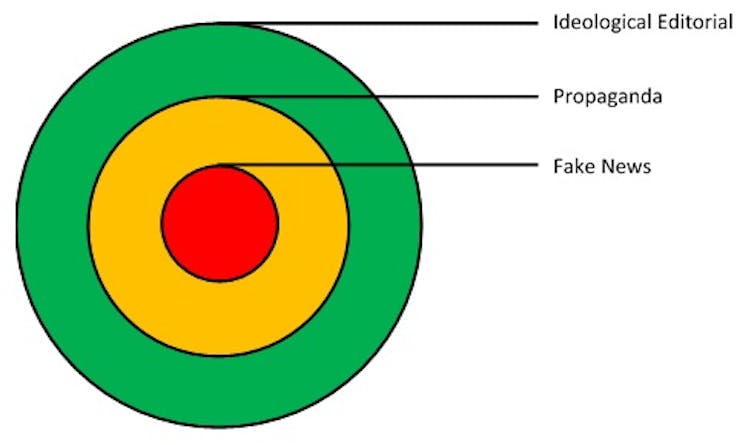Being more media savvy won’t stop the spread of ‘fake news’ – here’s why

Craig Harper, Nottingham Trent University
“Fake news” is the buzzword of 2017. Barely a day goes by without a headline about president Donald Trump lambasting media “bias”, or the spread of “alternative facts”.
Many articles on the subject suggest that social media sites should do more to educate the public about misinformation, or that readers should think more critically about the sources of news stories before sharing them. But there are fundamental problems with this. First, there isn’t a clear definition of what “fake news” really is. And second, it overlooks important aspects of people’s psychological makeup.
“Fake news” can be classified in a number of ways and represented as a series of concentric circles. First, in the centre of the concentric model, we have actual fake news. These are the stories that we commonly see shared on sites such as News Thump and The Onion. These satirical stories are written for comedic purposes and are put together to entertain.
Next, we have propaganda articles. Typically, these pieces do not actually contain any real news value. They may, for example, detail an individual’s past behaviour and suggest that that it reflects something about their current intentions. Alternatively, these pieces may contain some kernel of truth, but this may be twisted in such a way that it totally misleads audiences and misrepresents a story’s true news value.
These propaganda articles take numerous forms. The Huffington Post, for example, included a caveat about Donald Trump’s alleged bigotry whenever mentioning him in a story before the US election last November, while British readers will likely recall the Daily Mail’s much-maligned attacks on former Labour leader Ed Miliband’s late father in 2013, calling him a “man who hated Britain”.
Finally, and occupying the outermost ring of the model, there are the stories that are technically true, but reflect the subtle editorial biases of the organisation publishing them. This reporting is commonplace within the mainstream media, through selective storytelling and politically-driven editorials. Whether this is reflected in the left-wing bias of The Guardian or the right-wing approach of the Murdoch media empire, this practice is less malicious and more a political interpretation of events.

A tale of two biases
Despite the widespread use of the label, only one of these rings – the central and smallest group – is legitimately “fake news”. Stories in the outer two rings are not necessarily “fake”, and they may or may not actually be “news”. But if particular companies take editorial positions on particular issues, that in itself is not a problem. The important issue is how we interact with these viewpoints.
The meme of “fake news” provides a new and socially approved way of indulging some of our core psychological and political bias. Confirmation bias is a label used by psychologists to describe the tendency that people have to search for and interpret information in a way that corresponds with their preexisting beliefs, preferences and attitudes. Quite simply, we are more inclined to believe a story, and share it with others, when its content corresponds with our opinions. Similarly, we are more likely to brand stories we don’t agree with “fake news”.

Shutterstock
It all comes down to who we are. The idea of ontological security suggests that people are motivated to maintain a clear and consistent sense of their own identity and the environment around them. When they are confronted with a story that goes against their view of the world, therefore, they impulsively reject its core messages.
That said, there are clearly some stories that we may disagree with, but which also feature key arguments that make logical sense. If this is the case, we seek to discredit the sources rather than the argument. We attribute ulterior motives to them in order to bolster “our” side. In the current climate, we call them “fake news”.
The way forward
Data shows how online communities are increasingly becoming ideologically pure “echo chambers”. This trend contributes to a rising intolerance of anything that does not quite fit with a particular worldview. People share things that match their beliefs, and disparage anything that does not. What’s more, with the click of a button or the swipe of a smartphone, individuals can now block, unfriend, and unfollow anybody promoting “deviant” views. We cleanse the chamber from within.
It is clear, then, that being more “media savvy” is unlikely to counter innate psychological biases. But there is a need for more diversity of opinion within social networks. Research suggests that contact between groups can lead to reduced polarisation and conflict. It is only by confronting legitimate opposing viewpoints on a regular basis that we can truly recognise fake news when we see it. Quite how we do this in an era of political polarisation, however, remains an open question.![]()
Craig Harper, Lecturer in Human Psychology, Nottingham Trent University
This article is republished from The Conversation under a Creative Commons license. Read the original article.
